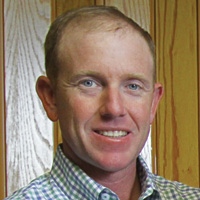Coping with a Tough Climate

 Travis Larson
Travis Larson
Okeechobee, Fla.
Larson is a third-generation dairy producer in southern Florida, milking 4,200 cows.
Successful herd health and breeding programs in the heat-stressed environment of South Florida are easier to read about than to accomplish. With our high fluid-milk price comes eight-plus months of hot, humid weather that is suitable for growing forages but not transitioning cows and getting them bred.
Weather is the greatest challenge we face when trying to keep cows healthy and reproductively sound. Our first frost of 2011–12 was on Jan. 4, 2012, with only a handful of nights before then reaching below 50°F. For most of December, we had lows near 70°F and highs in the upper 80s. The plus side of the heat and humidity is that we had chopped haylage, corn silage and/or sorghum silage seven out of the 12 months in 2011.
Our herd health program at Larson Dairy starts with a successful transition period from dryoff to freshening. This includes a separate, far-off dry-cow ration, followed by a close-up total mixed ration with DCAD. We monitor urine pH on close-up cows and constantly check body condition scores close to calving.
We follow a strict protocol for dryoff procedures. Cows are dried off with Albadry and Orbeseal. Vaccinations at dryoff include Triangle 4, Ultrabac 8 and SRP. Treatment at 25 days pre-partum includes vitamin E and SRP vaccination. At freshening, all cows receive oxytocin, vitamin B12 and vitamin E. After a clear Delvotest, cows and heifers enter separate fresh pens. Fresh cows and heifers are kept separate five to six months per year as space allows.
When fresh cattle advance to the freestall barns, cows are temped for 10 days and checked for ketosis, displaced abomasum, milk fever and metritis daily. Problem cows with a fever or clinical metritis are treated with Excenel. If symptoms persist, they are moved to the hospital pen and begin treatment with Polyflex.
Our freestall barns are set up with 4' fans every 40' and overhead sprinkler lines in the feed alley to keep dry-matter intake up through multiple hot months. During dry conditions, we maintain bedding by sanding one freestall barn each day. When it rains, we groom all pens each day to avoid adding wet sand, which could result in Klebsiella mastitis.
On all shifts, our pusher rakes out the back of all freestalls when he brings a herd to be milked. We spray our freestall beds with Tek-Trol three times per week to prevent bacterial growth. We also manually dig out the rear one-third of all freestall beds once a year, in May. We have installed rubber belting along all feed alleys and along most cow lanes to help get cattle off concrete.
Open cows and death loss are huge factors to economic success. We strategically plan around not calving top-rated cows in August and September because of the increased death loss of fresh cows during those months. To compensate for the loss of milk production, we add a lot of springing heifers in June and July because heifers adapt to the heat and humidity much better than cows.
Our voluntary waiting period is 60 days in milk and cows get three shots of prostaglandin at 28 DIM, 58 DIM and 72 DIM. We breed off of the last two shots. If cows are still open at 86 DIM, they are enrolled in our Ovsynch program. To shorten days open, we pre-synch our pregnancy checks with GnRH and open cows receive prostaglandin on preg-check day. This is followed by a GnRH shot 56 hours later, and cows are bred the following day.
Since we don’t breed our top-rated cows in November or December, January is when we catch up on our breedings. We use Pre-Synch 14 followed by Ovsynch to catch up on between 400 and 600 breedings. Our conception rates are very low in the summer months, so we strive to have 50% of our cowherd pregnant by May 1. We rely on a great deal of preventive measures and planning to ensure our cows are healthy, comfortable and reproducing in this tough climate.
| Larson's Most Recent Prices | |
| Milk (3.69% bf, 4.0% prt) | $25.19/cwt. |
| Cull cows | $76/head |
| Springing heifers | $1,500/head (delivered) |
| Cottonseed | $314/ton |
| Ground corn | $271/ton |
| Corn silage | $50.65/ton (delivered) |
| Citrus pulp | $158.25/ton fob |
| Dry distillers' grains | $237/ton fob |







